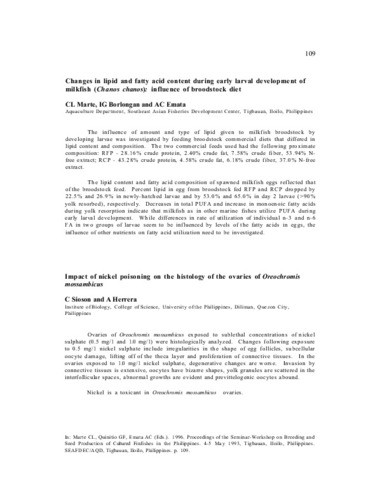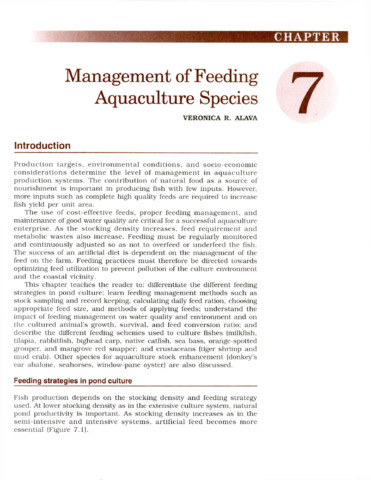Changes in lipid and fatty acid content during early larval development of milkfish (Chanos chanos): influence of broodstock diet
- Global styles
- MLA
- Vancouver
- Elsevier - Harvard
- APA
- Help

Date
1996Page views
5,645ASFA keyword
AGROVOC keyword
Taxonomic term
Metadata
Show full item record
Share
Abstract
The influence of amount and type of lipid given to milkfish broodstock by developing larvae was investigated by feeding broodstock commercial diets that differed in lipid content and composition. The two commercial feeds used had the following proximate composition: RFP - 28.16% crude protein, 2.40% crude fat, 7.58% crude fiber, 53.94% N-free extract; RCP - 43.28% crude protein, 4.58% crude fat, 6.18% crude fiber, 37.0% N-free extract.
The lipid content and fatty acid composition of spawned milkfish eggs reflected that of the broodstock feed. Percent lipid in egg from broodstock fed RFP and RCP dropped by 22.5% and 26.9% in newly-hatched larvae and by 53.0% and 65.0% in day 2 larvae (>90% yolk resorbed), respectively. Decreases in total PUFA and increase in monoenoic fatty acids during yolk resorption indicate that milkfish as in other marine fishes utilize PUFA during early larval development. While differences in rate of utilization of individual n-3 and n-6 FA in two groups of larvae seem to be influenced by levels of the fatty acids in eggs, the influence of other nutrients on fatty acid utilization need to be investigated.
Description
Abstract only.
Suggested Citation
Marte, C. L., Borlongan, I. G., Emata, A. C. (1996). Changes in lipid and fatty acid content during early larval development of milkfish (Chanos chanos): influence of broodstock diet. In: Marte C L, Quinitio G F, Emata A C (Eds.). Proceedings of the Seminar-Workshop on Breeding and Seed Production of Cultured Finfishes in the Philippines. 4-5 May 1993, Tigbauan, Iloilo, Philippines. (p. 109). Tigbauan, Iloilo, Philippines: Aquaculture Department, Southeast Asian Fisheries Development Center.
Type
Conference paperISBN
9718511326
Related items
Showing items related by title, author, creator and subject.
-
Management of feeding aquaculture species
Alava, Veronica R. (Aquaculture Department, Southeast Asian Fisheries Development Center, 2002)This chapter teaches the reader to: differentiate the different feeding strategies in pond culture; learn feeding management methods such as stock sampling and record keeping, calculating daily feed ration, choosing ... -
Potential of feed pea (Pisum sativum) meal as a protein source in practical diets for milkfish (Chanos chanos Forsskal)
Borlongan, Ilda G.; Eusebio, Perla S.; Welsh, Tim (Elsevier, 2003)A 12-week feeding trial was conducted to evaluate the use of feed pea meal as a dietary protein source for juvenile milkfish. Six isonitrogenous (30% crude protein) and isocaloric (16.5 kJ/g) practical diets were formulated. ... -
A preliminary study on the purified test diet for young milkfish, Chanos chanos
Lee, Dong-Liang; Liao, I-Chiu (Aquaculture Department, Southeast Asian Fisheries Development Center, 1976)In studying the nutritional requirements of young milkfish experiments were conducted to develop a purified test diet. Mixtures of the purified constituents tested were: vitamin-free casein, vitamin-free gelatin, supplemented ...






